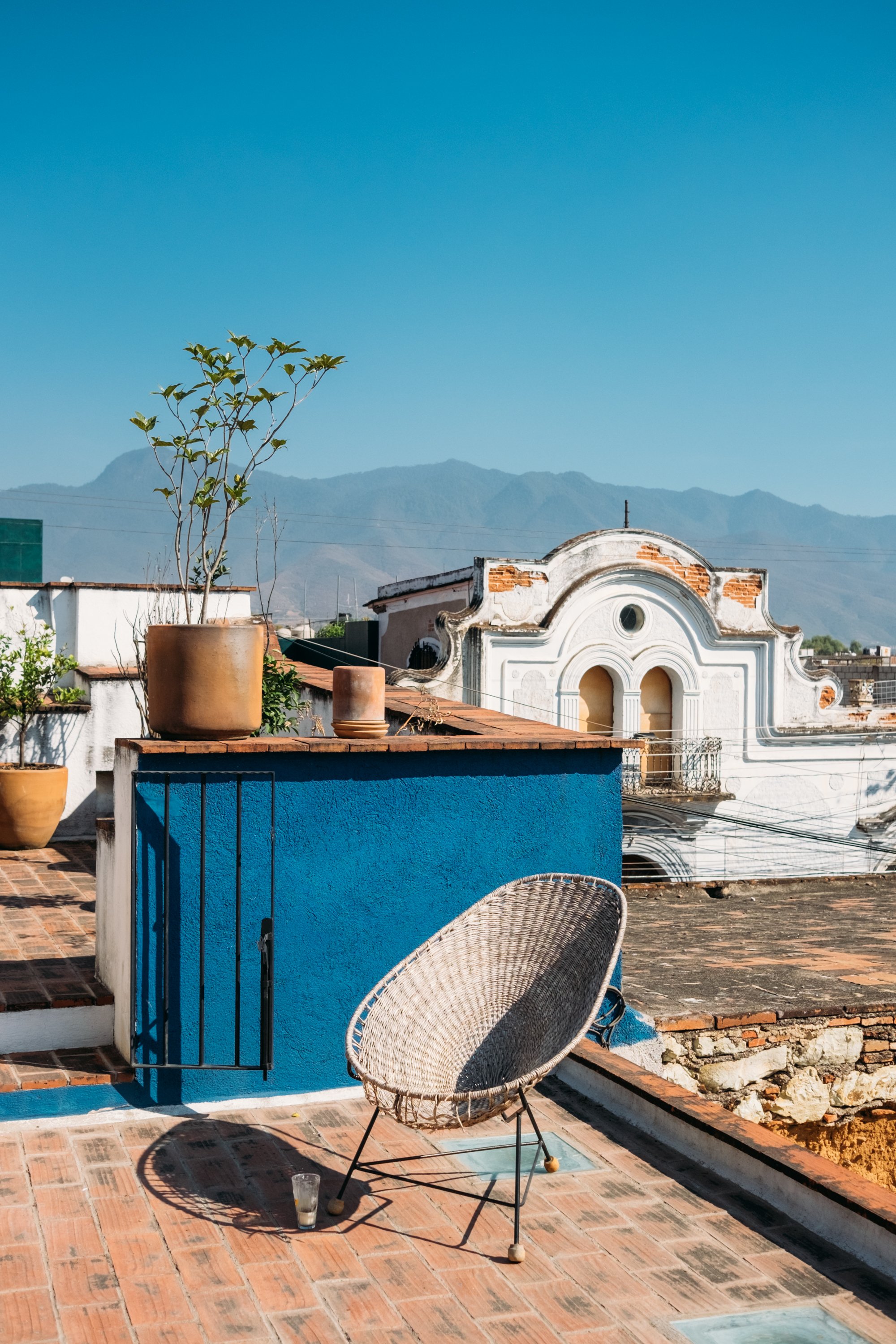
To mark the highly anticipated release of Maestro Dobel 50 Cristalino in the US, the spirit-maker’s new, ultra-refined Cristalino tequila, Artnet is teaming up with the brand to honor the Pocoapoco artists’ residency in the south of Mexico and to celebrate the rich connections between tradition, innovation, and a spirit of intelligent elegance.
It appears like a dream.
Embedded in the Mexican landscape, framed by mountains in the middle distance, the house that hosts the Pocoapoco artists’ residency is set also amid a bustling city dotted with brightly painted houses. Against the backdrop of buildings adorned in lush, uniform colors—green, red, white—the Pocoapoco house stands out sharply and handsomely, painted in vibrant blue.
The dream is a reality. The residency, founded by Jessica Chrastil on the principles of conversation, shared research, and focused reflection, has hosted dozens of artists, writers, researchers, even scientists and social workers. The goal is at once simple and profound: to offer its residents, who come in groups of six or eight for around a month at a time, a place to grow amid Mexico’s exploding contemporary art scene and the traditions born of the country’s long and distinguished cultural history.
A look at the mountains above Pocoapoco. Photo: Aileen Son.
The beginnings of Pocoapoco were quiet.
“The residency itself began as just a few trial week-long programs out of a friend’s local hotel that we had to beg our friends to come to,” says Chrastil, who remains the program’s director.
It blossomed from there: among the residents who have passed through its halls are Delphine Desane, the French-Haitian artist whose depictions of women in tropical settings have a lucid yet surreal vibe; Cheryl Humphreys, the Los Angeles-based artist who makes art an instrument and practice for healing; and Mariana Garibay Raeke, the Guadalajara-born artist whose craft focuses on color’s tremendous transformative power.
“Many residents come to the program during times of transition of some sort, looking to explore and rethink why they are doing what they are doing, what connects them to their work and the choices they’ve made,” Chrastil says. “There is something about Oaxaca’s deep connection to this history, traditions, and land that I think forces people to take a new perspective on their creative practice, purpose, and process. Priorities and pace are different here. How people connect with each other is different here.”
A view of the building that houses the Pocoapoco residency. Photo: Pia Riverola.
Beyond the residency, Pocoapoco also maintains a close relationship with La Señora, a partner gallery that supports and collaborates with mid-career Oaxacan artists whose work challenges traditional notions of contemporaneity in Oaxaca, bringing their art to an international audience. (As part of that partnership, the organizations have just launched a sale of small-scale works on paper by 10 up-and-coming Oaxacan artists.)
To celebrate Pocoapoco’s marked contributions to the development of contemporary art in Mexico and around the world, Maestro Dobel Tequila—which itself is founded on the principles of respecting tradition and a deep concern for how to evolve while staying true to heritage—is partnering with Artnet to further its work and promote the culture of Mexico.
Maestro Dobel Tequila sees a clear alignment between its ideals and those of Pocoapoco. Founded by Juan Dobel, an 11th-generation tequila maker, the brand was the very first to create Cristalino tequila, the sparkling clear spirit refined beyond what was previously believed possible.
Maestro Dobel Diamante, the world’s first-ever Cristalino tequila.
This year, in honor of the 50th anniversary of Juan Dobel, Maestro Dobel Tequila will release Maestro Dobel 50—a smooth and complex Extra Añejo Cristalino with notes of fig, date, and pumpkin, alongside hints of cinnamon, vanilla, and clove—in the US.
The brilliant spirit, which is aged in American and Eastern European oak barrels, is a stunning innovation built on over 250 years of Dobel family experience.
(Maestro Dobel Tequila’s partnership with Artnet and support of Pocoapoco is just the latest in its long history of support for the arts. Last December, on the occasion of Art Basel Miami Beach, the brand unveiled the fruits of its yearlong collaboration with the UK-born artist Julian Mayor.)
Maestro Dobel 50, a smooth and complex Extra Añejo Cristalino with notes of fig, date, and pumpkin, alongside hints of cinnamon, vanilla, and clove.
Amid everything—a bustling program, a growing gallery scene, and incoming residents from around the world—Chrastil is looking to the future, continually imagining what novel ideas and new traditions can come out of the extraordinary program she founded.
What would she like to see happen in 10 years’ time?
“I hope it will continue to grow deeper,” she says of the program, stressing that growth must be focused and sustainable. “I believe that all of us who are part of this project are not so much interested in the program expanding as we are in continuing to ground it in what we are already doing.”
What better way to build on an already rich legacy?
Learn more about the artists who have passed through the Pocoapoco artists’ residency:
‘I Left With Lifelong Connections’: What Artist Cheryl Humphreys Learned in Mexico at the Pocoapoco Residency
‘I Wanted to Reconnect With the Land’: How Artist Mariana Garibay Raeke Retooled Her Sensibilities at the Pocoapoco Residency
‘Each Village Has Its Own Tradition’: Artist Delphine Desane on the Cultures of Mexico and the Pocoapoco Residency